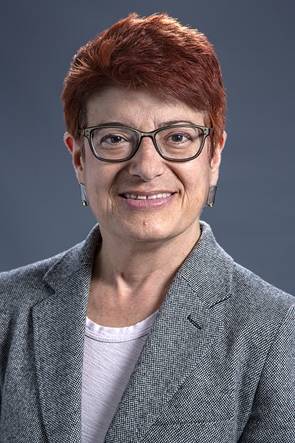- After becoming the radiology chair at Emory University School of Medicine, Carolyn C. Meltzer, MD, FACR, discovered pay inequities between men and women within the department.
- Meltzer created a new payment system based on the Association of American Medical College’s salary benchmarks and a new incentive system for the department.
- The new system closed the payment gap and opened doors for further diversity, equity, and inclusion efforts.
When Carolyn C. Meltzer, MD, FACR, became chair of radiology and imaging sciences at Emory School of Medicine in 2007, she uncovered stunning findings while researching the department’s structure and salaries. In particular, she found the considerable compensation gaps between male and female faculty members astounding.
“I tried to piece together the differences in faculty salaries and found a significant gap between the compensation of men and women assistant professors — with male faculty members averaging $20,000 more than female faculty members,” says Meltzer, who is also the William P. Timmie Professor and executive associate dean of faculty academic advancement, leadership, and inclusion. “It was so glaring that I knew it had to be addressed immediately.”

Carolyn C. Meltzer, MD, FACR, chair of radiology and imaging sciences at Emory School of Medicine, found that male faculty members were earning an average of $20,000 more than female faculty members. |
While the finding was disappointing, it wasn’t entirely surprising. Research shows that inequities in salaries, incentives, resources, and awards proliferate throughout medicine, Meltzer says. These inequities are based on gender, race, and ethnicity. The Association of American Medical College (AAMC) Group on Women in Medicine and Science reports that gender is a main driver of salary inequity. Such inequities can negatively affect the department, leading faculty to feel undervalued and ultimately resulting in disengagement and poor department morale. It can further hinder a department through retention and recruitment costs and productivity losses.1
Recognizing this, Meltzer formed a team to reengineer the department’s compensation structure, transforming it from one based on relative value units (RVUs) to one based predominantly on national academic benchmarks. The new structure also includes a points-based incentive system that gives faculty members equal credit for reading all types of imaging studies as well as credit for non-RVU generating work. Through these efforts, Meltzer led her team in closing the compensation gap and creating a more equitable culture. It’s all part of the department’s overarching goals to make the department more diverse, equitable, and inclusive. (Read more about this work in this Imaging 3.0 case study.)
Reflecting on RVUs
In the past, the radiology department compensated radiologists based largely on the number of RVUs they generated. “But RVUs are not true value markers,” says Jamlik-Omari Johnson, MD, FASER, vice chair for diversity, equity, and inclusion in the radiology department at Emory. “They are not precise, and they rarely take into account other performance factors, such as teaching and interacting with patients.” Given that female faculty members generally have larger service and teaching loads, RVU-based formulas can introduce gender inequity into the compensation structure,2 Meltzer adds.
Plus, Johnson says, the way RVUs are valued opens the door to potential conflicts. For example, focusing on RVU metrics can lead people to do things like cherry-pick high-RVU studies while leaving lower-RVU examinations for others to interpret. Meltzer adds, “The emphasis on doing as many high-RVU activities as possible does not promote a collaborative workforce.”
For these reasons, Meltzer knew that the department needed to redesign its compensation structure to move away from RVUs. She convened a group of department leaders to examine the best way to make salaries more equitable for all radiologists. As a starting point, they elected to align base salaries with the AAMC’s academic rank benchmarks. Then, the peer faculty committee developed an incentive plan framework that valued teaching, research, service, quality work, and overall clinical effort.
Realigning base salaries meant that those who had significantly higher salaries than their peers would remain at that pay rate while the others caught up. This was difficult news for some of faculty members to hear, but Meltzer says that being transparent from the beginning was key to getting them on board. “I told them right off the bat that their salaries were higher than the benchmarks we were using and that they wouldn’t be able to get a raise until others caught up,” she says.
Emphasizing Value
Once the base salaries were set, the leadership team focused on emphasizing the value of collaboration within the department. To that end, they created a monetary incentive to encourage faculty members to dedicate time to non-RVU generating activities, such as answering questions from referring physicians and interacting with patients. They categorized this work under four pillars:
- Divisional clinical productivity/quality
- Individual clinical/quality
- Academic (research and teaching)
- Service/citizenship
Each pillar was based on the values and vision identified in the department’s strategic plan. From there, a faculty workgroup developed the metrics and point values that correlate with each pillar. For instance, if a faculty member participates on a committee (whether at the department or national level), they gain a certain number of points in the service/citizenship pillar. Similarly, a faculty member could do something as simple as volunteering for extra clinical duty and also receive credit in that pillar. Each activity counts as a single point. The resulting incentive payment is based on cumulative points. An individual can receive a maximum of 10 points in each pillar.
|
Jamlik-Omari Johnson, MD, FASER, vice chair for diversity, equity, and inclusion in the radiology department at Emory, says that pay structures based on relative value units are imprecise and ripe for conflicts. |
Faculty members track their points through several methods. Members track and self-report activities, such as lectures, committee participation, and manuscripts published, through a templated spreadsheet. Administration staff assists by tracking participation in activities such as RadPeer, resident conferences given, and attendance at grand rounds and faculty meetings. “With this system, we don’t weigh divisional RVU performance above individual RVU performance because we don’t want to use this singular measure to suggest the importance of one faculty member versus another,” Meltzer explains. “If one person is reading MRIs and another is doing chest radiographs, they’re still doing the same work even though one test generates more RVUs than the other.”
Closing the Gap
At the time, departments were fairly autonomous at Emory, so transitioning to the new compensation model required the leadership team to foster intradepartmental discussions that ensured that the plan and the process were as transparent as possible. This was largely done by including faculty members in the workgroup that created the incentive system.
“Faculty members helped create the system based on their own values, which achieved much more buy-in than a top-down approach,” explains Meltzer, who also ensured that everyone in the department was kept up to date as decisions were made. “Everyone knew what was happening every step of the way, so nothing was a surprise.”
As the radiology department instituted the new payment system, it tracked the point distribution across the faculty. Leaders oriented faculty members with the new system during faculty meetings. The department also embedded guidelines within the spreadsheet itself so that faculty members could refer to them when needed. Department directors reviewed each spreadsheet to ensure they were completed correctly.
Within two years into Meltzer’s tenure as chair, the team eliminated the pay gap. Plotted on a graph, the incentive points formed a bell-shaped curve with no systematic gender effect, suggesting that bias had been mitigated. “I was relieved when everything came together,” Meltzer says. “It was difficult for me as a new chair to confront my faculty with the revelation that some in the department (predominantly women) were being underpaid compared to some of their colleagues with the same experience and position. Our department really appreciated the transparency, though, and wanted to correct the problem.”
Seeing an Impact
Closing the pay gap between men and women at Emory has not only improved morale, but it has also promoted a larger culture of collaboration among faculty members. “Without a focus on RVUs, we don’t have individuals competing to get the high-RVU driven exams. Instead, faculty are incentivized based on their strengths and work responsibilities,” Meltzer says, adding that including faculty in the creation of the plan and being transparent throughout the process strengthened faculty members’ overall support of leadership.
Not everything has been perfect, however. “There have been times when we’ve lost a recruit because the individual wanted to negotiate for a higher salary, and we refused,” explains Meltzer. “But we’re a team first and foremost, and equity is important. We can’t negotiate a higher salary, but we can pledge that as faculty you won’t find yourself seeing a new recruit or colleague valued more than you. Most recruits find this reassuring.”
For other radiology groups looking to address similar inequities in their systems, Meltzer says that the most important thing to is to get started. “Without a system in place that specifically ensures equity along gender, race, and ethnicity, you’ll likely have some kind of gap somewhere. The first step is examining the data and being transparent about what it shows. The hard work to reveal and then address inequities is often the first step in the journey toward a truly inclusive work climate.”
End Notes
1. American Association of Medical Colleges. “Understanding and Addressing Faculty Salary Equity Toolkit.” American Association of Medical Colleges. 2019. aamc.org/data-reports/faculty-salary-equity
2. Guarino, C.M., Borden, V.M.H. Faculty Service Loads and Gender: Are Women Taking Care of the Academic Family?. Res High Educ 58, 672–694 (2017). https://doi.org/10.1007/s11162-017-9454-2.
Creative Commons
Improving Pay Equity by American College of Radiology is licensed under a Creative Commons Attribution-NonCommercial-NoDerivatives 4.0 International License. Based on a work at www.acr.org/imaging3. Permissions beyond the scope of this license may be available at www.acr.org/Legal.
Share Your Story
Have a case study idea you’d like to share with the radiology community? To submit your idea please click here.
Now It's Your Turn
Follow these steps to begin examining compensation in your practice, and tell us about it at imaging3@acr.org or on Twitter with the hashtag #Imaging3:
- Examine the payment and incentive data in your department or practice. Look at compensation, start-up packages, space allocation, honors and awards, and teaching and other subjective performance evaluations.
- Take a look at established standards, such as the AAMC’s academic rank benchmarks. How does your data compare with the benchmarks? Are salaries and other incentives equal among faculty based on experience and rank?
- Compile your findings and present them to your team. Begin brainstorming together about how to create a collaborative process that seeks to change inequities.
Author
Meghan Edwards, freelance writer
Join the Discussion

#Imaging3 on Twitter
Call for Case Studies

